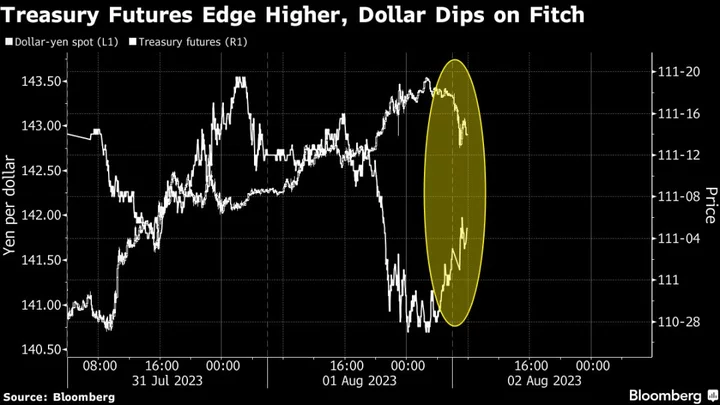The US sovereign rating may have slipped but Treasuries remain a buy.
That’s the prognosis of strategists, who say US government bonds will still be the cornerstone of portfolios even after Fitch Ratings cut the nation’s AAA credit grade. The reason? There are few assets that can rival Treasuries’ status as the haven of choice.
“Because Treasury securities are such an important asset class, most investment mandates and regulatory regimes refer to them specifically, rather than AAA-rated government debt,” Goldman Sachs Group Inc. economists including Alec Phillips wrote in a note. “We do not believe there are any meaningful holders of Treasury securities who will be forced to sell due to a downgrade.”
The view was reflected in market moves on Wednesday as short-end Treasuries rose and a gauge of the dollar reversed a drop to edge higher. Taking the US out of the equation, investors have a limited pool of AAA-rated sovereign debt to choose from. Economies with the highest credit rating at S&P Global Ratings, Fitch and Moody’s Investors Service include Germany, Denmark, Netherlands, Sweden and Norway.
Such rating cuts “are a bit like these debt ceiling debacles — they can cause a bit of short term angst, but never amounts to anything much,” said Amy Xie Patrick, money manager in at Pendal Group. There needs to be a “credible alternative in terms of both being safe enough and large enough” to displace Treasuries, and there are no clear options now, she added.
Fitch cited the US’ ballooning fiscal deficits among the reasons for its decision, which echoes a a move made more than a decade ago by S&P Global Ratings.
2011 Downgrade
S&P’s rating cut in 2011 triggered a selloff in risk assets such as global equities, but boosted Treasuries as investors sought out havens. Yields on 10-year Treasuries slid 24 basis points on Aug. 8 that year, the first trading day after the S&P downgrade.
Fitch’s decision fueled a similar reaction on Wednesday, with Asian stocks declining and the two-year Treasury yield falling as much as three basis points. Benchmark 10-year US yields edged up one basis point to 4.03% after declining two basis points.
“Treasuries still provide the broad risk off hedge during periods of stress, which ironically, the downgrade may morph into,” said Marvin Loh, global macro strategist at State Street Corp. “When we look at 2011, credit and stocks initially were the most volatile following the S&P downgrade.”
“We do not believe the Fitch downgrade will have a huge market impact, as this brings the US into line with S&P ratings,” said James Wilson, senior portfolio manager at Jamieson Coote Bonds in Melbourne. “The financial system has weathered much bigger storms since then, and the bigger factor toward higher yields is the glut of Treasury supply that is set to come through the market with the larger coupon announcement.”
On Monday, the Treasury raised its net borrowing estimate for the July-through-September quarter to $1 trillion, more than some analysts expected and well above the $733 billion it had predicted in early May. The Treasury will preview its quarterly financing plans on Wednesday at 8:30 a.m. in Washington.
Borrowing Risk
Some commentators including Larry Summers and Mohamed El-Erian have criticized Fitch’s decision given US economic resilience. Summers, a former Treasury Secretary, said while there were reasons for concern about the long-run US deficit trajectory, the nation’s ability to service its debts isn’t in doubt.
Yields on 30-year US debt climbed eight basis on Tuesday and held at 4.10% in Asia Wednesday, around the highest level since November.
What Bloomberg Strategists Say...
“There shouldn’t be much lasting impact on Treasuries as Fitch put the US onto a stable outlook from negative. That means another move is very unlikely — its a one-and-done operation and marking to market with S&P’s AA+ rating.”
Mark Cranfield, Markets Live strategist
While some parts of the US curve face selling pressure, the consensus is that demand for Treasuries will persist as investors struggle to find other safe and liquid options to park their cash in.
“The Fitch downgrade will have minimal negative impact on the allure of US Treasuries,” said Chang Wei Liang, strategist at DBS Bank Ltd. in Singapore. In fact, it “may ironically support Treasuries buying on concerns of follow-on downgrades to US corporate credit.”
--With assistance from Michael G. Wilson.









